CPQ Orthopaedics (2022) 6:1Theoretical Paper
Disorder in Children - Pain Syndromes in Adults - Problems of
Spine, Hips, Feet - In Points and Figures
Karski Tomasz1*, Jacek Karski2, Klaudia Karska2, Katarzyna Karska2 & Honorata Menet3
1Vincent Pol University in Lublin, Poland
2Medical University in Lublin, Poland
3University in Caen, France
*Correspondence to: Dr. Karski Tomasz, Vincent Pol University in Lublin, Poland.
Copyright © 2022 Dr. Karski Tomasz, et al. This is an open access article distributed under the Creative Commons Attribution License, which permits unrestricted use, distribution, and reproduction in any medium, provided the original work is properly cited.
Received: 21 February 2022
Published: 01 March 2022
Keywords: Syndrome of Contractures and Deformities; Minimal Brain Dysfunction; Spine; Hips; Feet;
Scoliosis; Prophylaxis; Therapy
Abstract
In the article there is described the Syndrome of Contractures and Deformities, Minimal Brain
Dysfunction, etiology of So-Called Idiopathic Scoliosis with information about new classification
and about old - improper and new - proper therapy. In article there are giving also the rules of
prophylaxis and therapy for hips in children and in adults. It is presented also information about
geothermal water in physiotherapy of locomotors system disorders and pain syndromes.
Introduction
In orthopedics it is important proper diagnosis, proper therapy - firstly - conservative - if not sufficient -
surgery. The prophylaxis of pain syndromes in hips, knees, feet and spine in adults - should be started in
child period of life [1-37]. For the prophylaxis of hip arthrosis - it is important to cured completely dysplasia
of the hips in baby and infants period of life. In article is also given the information about - insufficiency of feet connected with limited plantar flexion of toes and “pain syndromes” connected with improper getting
out the car - on one leg / on one foot. The article described also the beneficial properties of geothermal
water in therapy of orthopedic disorder [38-42]. All observations are based on material of many thousand
of patients from years 1961 - 2020, but especially from years 1995 - 2021.
In contents of this publications there are presented:
1) Problems of Minimal Brain Dysfunction,
2) Sydnrome of Contractures and Deformities,
3) Problems of hip - children and adults,
4) So-Called Idiopathic Scoliosis - etiology, classification, therapy - old incorrect and new - proper / correct,
5) Feet problems,
6) Geothermal water in physiotherapy,
1) Problems of Minimal Brain Dysfunction (Fig. 1) - (A) (B) (C) (D) (E) (F) (G). Very frequent - in ours
material about 15% of causes - anamnesis inform that the pregnancy and delivery were incorrect. Its mean
- for the fetus - could be asphyxia process. In result - the neuro - pathological disorders, next changes in
child’s growths, next dysfunctions and pathological changes in “whole movement apparatus”. In this group
of patients there are also psychological changes. In figures we present disorders in hips, pelvis, knees and feet
and also symptoms of general laxity according Wynne Davies.
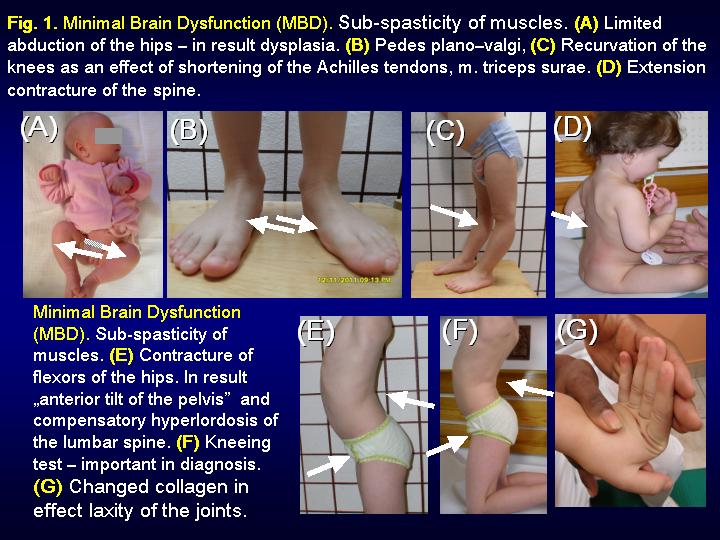 Figure 1: Minimal Brain Dysfunction (MBD). Sub-spasticity of muscles. (A) Limited abduction of the hips -
in result dysplasia. (B) Pedes plano-valgi, (C) Recurvation of the knees as an effect of shortening of the Achilles
tendons, m. triceps surae. (D) Extension contracture of the spine. (E) Contracture of flexors of the hips. In result
„anterior tilt of the pelvis” and compensatory hyperlordosis of the lumbar spine. (F) Kneeing test - important in
diagnosis. (G) Changed collagen in effect laxity of the joints.
Figure 1: Minimal Brain Dysfunction (MBD). Sub-spasticity of muscles. (A) Limited abduction of the hips -
in result dysplasia. (B) Pedes plano-valgi, (C) Recurvation of the knees as an effect of shortening of the Achilles
tendons, m. triceps surae. (D) Extension contracture of the spine. (E) Contracture of flexors of the hips. In result
„anterior tilt of the pelvis” and compensatory hyperlordosis of the lumbar spine. (F) Kneeing test - important in
diagnosis. (G) Changed collagen in effect laxity of the joints.
In details there are:
(A) Limited abduction of the hips, because of spasticity or sub - spasticity of adductors of hips - in result
can develop dysplasia.
(B) Pedes plano-valgi - compensatory deformations because of shorting of m. triceps surae and Achilles
tendon,
(C) Recurvation of the knees also as an effect of shortening of the Achilles tendons and m. triceps surae.
(D) Sub-spasticity of extensors of trunks and in result - extension contracture of the spine.
(E) Contracture of flexors of the hips. In result „anterior tilt of the pelvis” and compensatory hiperlordosis
of the lumbar spine.
(F) Kneeing test - important in diagnosis.
(G) Changed collagen in effect laxity of the joints.
2) Sydnrome of Contractures and Deformities (Fig. 2) - (A) (B). This pathology is connected with
improper “development conditions” for fetus in pregnancy period - from mother side - wrong anatomy of
pelvis, too small “amnion water”, or from child side - too big, too long body of the child - can arise - anatomy
deformations and functional asymmetry. The Syndrome of Contracture and Deformities had describe as
first Prof. Hans Mau form Tubingen (Germany 1970 - 1980) as Siebenersyndrom (German) - its mean
“Seven Contractures Syndrome” (SofC) (English). In 2006 we complete this SofC for eights deformity -
“Varus deformity of shanks” and from this time our diagnosis is “Sydnrome of Contracture and Deformities
“(SofCD).
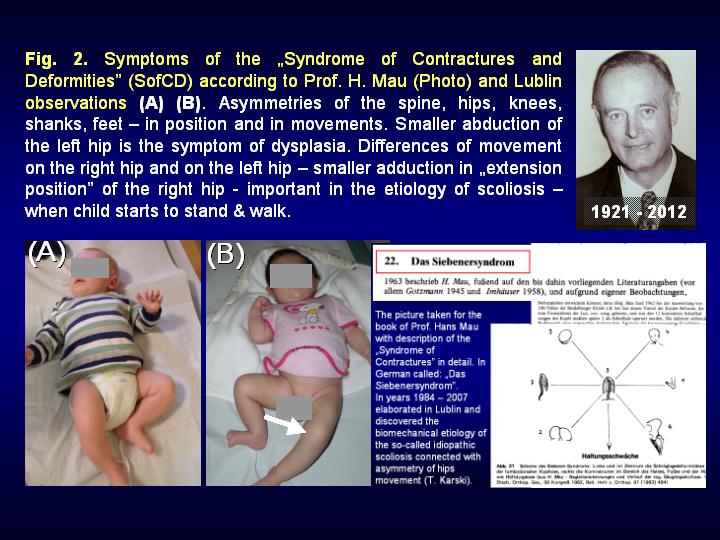 Figure 2: Symptoms of the „Syndrome of Contractures and Deformities” (SofCD) according to Prof. H. Mau
(Photo) and Lublin observations (A) (B). Asymmetries of the spine, hips, knees, shanks, feet - in position and in
movements. Smaller abduction of the left hip is the symptom of dysplasia. Differences of movement on the right
hip and on the left hip - smaller adduction in „extension position” of the right hip - important in the etiology of
scoliosis - when child starts to stand & walk.
Figure 2: Symptoms of the „Syndrome of Contractures and Deformities” (SofCD) according to Prof. H. Mau
(Photo) and Lublin observations (A) (B). Asymmetries of the spine, hips, knees, shanks, feet - in position and in
movements. Smaller abduction of the left hip is the symptom of dysplasia. Differences of movement on the right
hip and on the left hip - smaller adduction in „extension position” of the right hip - important in the etiology of
scoliosis - when child starts to stand & walk.
The are following symptoms in the “Syndrome of Contractures and Deformities” (SofCD) according to
Prof. H. Mau (Photo) and Lublin knowledge: asymmetries of the spine, hips, knees, shanks, feet - in position
and in movements. Smaller abduction of the left hip is the symptom of dysplasia observed in many children
in Poland and in other countries. Why left hip is more frequent affected - because 90 % or 95% of fetus are
placed on the left side of mother uterus (observation of gynecologists).
Differences of movement on the right hip and on the left hip - smaller adduction in „extension position” of
the right hip - important in the etiology of scoliosis - when child starts to stand & walk. These problems are
presented and described in next subchapters.
3) Hips - Children - Information about Proper and Improper Nursery (Literature 1-37).
A) Symptoms of the “Syndrome of Contractures and Deformities” (SofCD) according to Prof. H. Mau and
Lublin knowledge - explain many of deformations in children and adults. Very often we observe limitation of
the adduction mostly in left hip (Fig. 2). If the child is not treated or incorrect treated can develop dysplasia
or even dislocation of the femoral head (Luxatio coxae). Differences of movement right: left hip-smaller
adduction in „extension position” of right hip - there are important in the etiology of scoliosis (described by
T. Karski in 1995 - 2007) - when child starts to stand & walk and this problems is fully described in next
subchapters. (Fig. 8, 9, 10).
B) Wrong way of carrying of children - without abduction of hips - is the cause of improper development of
hips and even cusses to dysplasia. Such carrying is recommended by “poorly” educated or “over - educated”
doctors in many countries in Europe. Pictures are taken in Poland - left and abroad - in the middle and on
right (Fig. 3) - (A) (B) (C).
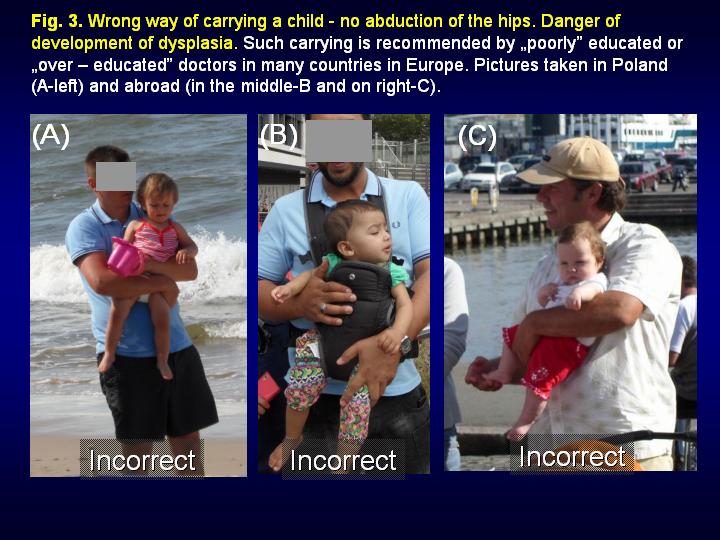 Figure 3: Wrong way of carrying a child - no abduction of the hips. Danger of development of dysplasia. Such
carrying is recommended by „poorly” educated or “over - educated” doctors in many countries in Europe. Pictures
taken in Poland (A-left) and abroad (in the middle-B and on right-C).
Figure 3: Wrong way of carrying a child - no abduction of the hips. Danger of development of dysplasia. Such
carrying is recommended by „poorly” educated or “over - educated” doctors in many countries in Europe. Pictures
taken in Poland (A-left) and abroad (in the middle-B and on right-C).
C) The correct way of carrying a child its mean assurance for good development of hips. Its mean - prophylaxis
of the hips dysplasia (Fig. 4) - (A) (B). Proper therapy of the wry neck (Fig. 4) - (C). Permanent rotation
stretching of the head to the wry neck side is only proper method of therapy. Articles about this treatment
were published in Germany and in USA [T. Karski 1991 & 2017].
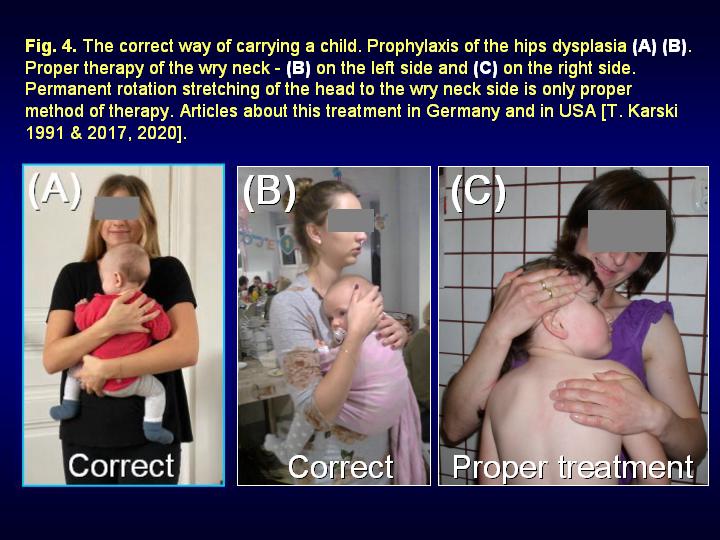 Figure 4: The correct way of carrying a child. Prophylaxis of the hips dysplasia (A) (B). Proper therapy of the wry
neck - (B) on the left side and (C) on the right side. Permanent rotation stretching of the head to the wry neck side
is only proper method of therapy. Articles about this treatment in Germany and in USA [T. Karski 1991 & 2017,
2020].
Figure 4: The correct way of carrying a child. Prophylaxis of the hips dysplasia (A) (B). Proper therapy of the wry
neck - (B) on the left side and (C) on the right side. Permanent rotation stretching of the head to the wry neck side
is only proper method of therapy. Articles about this treatment in Germany and in USA [T. Karski 1991 & 2017,
2020].
4) Problems of Hips - Adults.
A) If in child’s period of the life the hips are not treated perfectly - develop arthrosis - in this case in
the left hip with heavy symptoms - lateral position of the femoral head, deformations of the head, pain,
limping (Fig. 5) - (A). In the Figure 5 - (B) the process of arthrosis is in both hips - in right hip because of
permanent standing ‘at ease’ on the right leg. (Fig. 5) - (B). The Syndrome of Standing ‘at ease’ on the Right
Leg is described by T. Karski in 1997 (References 8 - 37).
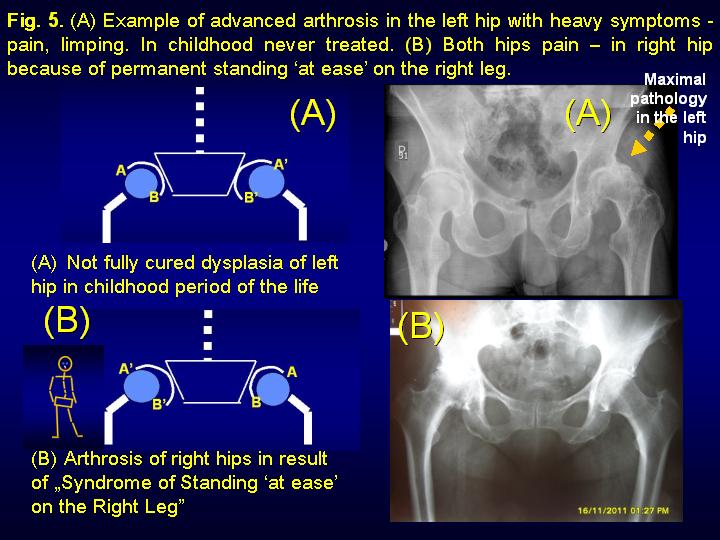 Figure 5: (A) Example of advanced arthrosis in the left hip with heavy symptoms - pain, limping. In childhood
never treated. (B) Both hips pain - in right hip because of permanent standing ‘at ease’ on the right leg.
Figure 5: (A) Example of advanced arthrosis in the left hip with heavy symptoms - pain, limping. In childhood
never treated. (B) Both hips pain - in right hip because of permanent standing ‘at ease’ on the right leg.
B) In prophylaxis and in therapy of hips arthrosis there is important standing. On the picture there are
presented physiotherapy methods for prophylaxis of arthrosis of the hips. A special form of standing and
sitting should be introduced at the age of 45 - 50. Standing in abduction and in internal rotation changes the
loading on the femoral heads, enables regaining internal rotation. Such standing - should be perform - every
day in every situation over many years (Fig. 6) - (A) (B).
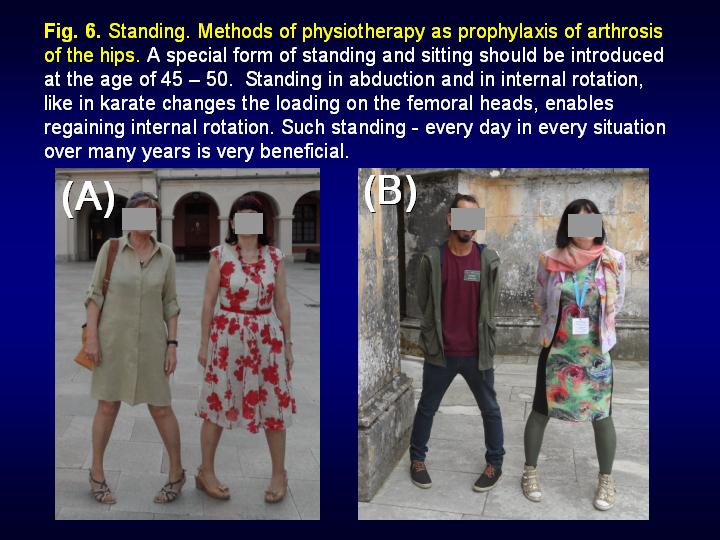 Figure 6: Standing. Methods of physiotherapy as prophylaxis of arthrosis of the hips. A special form of standing
and sitting should be introduced at the age of 45 - 50. Standing in abduction and in internal rotation, like in
karate changes the loading on the femoral heads, enables regaining internal rotation. Such standing - every day in
every situation over many years is very beneficial.
Figure 6: Standing. Methods of physiotherapy as prophylaxis of arthrosis of the hips. A special form of standing
and sitting should be introduced at the age of 45 - 50. Standing in abduction and in internal rotation, like in
karate changes the loading on the femoral heads, enables regaining internal rotation. Such standing - every day in
every situation over many years is very beneficial.
C) In prophylaxis and in therapy of hips arthrosis there is important also sitting. On pictures / figures is
proposed the methods of physiotherapy as prophylaxis of arthrosis of the hips. A special form of standing
and sitting should be introduced at the age of 45 - 50. Sitting - in internal rotation, what increases the range
of this movement. Patients should sit in this position every day in every situation. Sport in the form of
“Nordic walking” is also very important (Fig. 7) - (A) (B) (C) (D) (E).
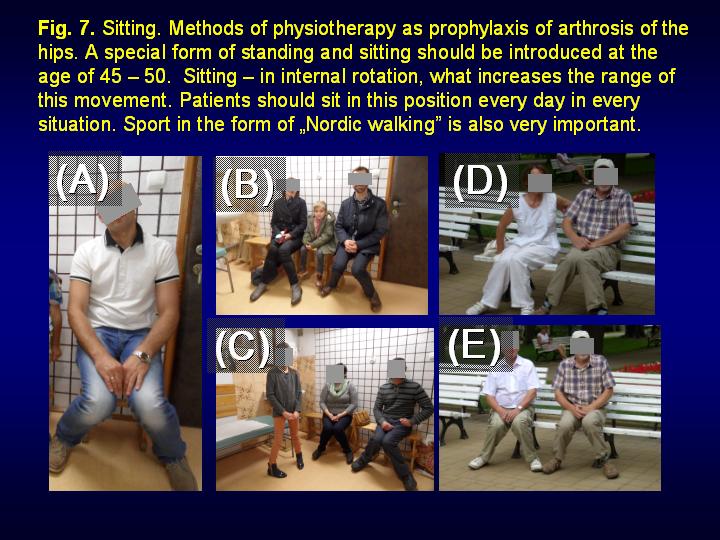 Figure 7: Sitting. Methods of physiotherapy as prophylaxis of arthrosis of the hips. A special form of standing and
sitting should be introduced at the age of 45 - 50. Sitting - in internal rotation, what increases the range of this
movement. Patients should sit in this position every day in every situation. Sport in the form of „Nordic walking”
is also very important.
Figure 7: Sitting. Methods of physiotherapy as prophylaxis of arthrosis of the hips. A special form of standing and
sitting should be introduced at the age of 45 - 50. Sitting - in internal rotation, what increases the range of this
movement. Patients should sit in this position every day in every situation. Sport in the form of „Nordic walking”
is also very important.
5) So-Called Idiopathic Scoliosis
In long years of observations (1984 - 2007) and research especially in years 1995 - 2007 - was described the
biomechanical etiology of the So-Called Idiopathic Scoliosis (T. Karski). Explanation of the developmental
of this spine deformity is connected with “asymmetry of movement of hips” - left versus right and next with
function “standing ‘at ease’ on the right leg” and walking. There are 3 groups & 4 types.
Groups (Fig. 8) - (A) (B) (C):
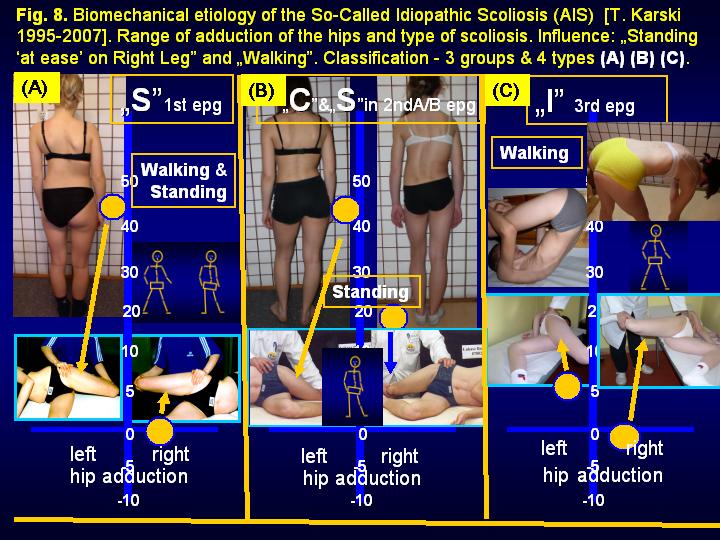 Figure 8: Biomechanical etiology of the So-Called Idiopathic Scoliosis (AIS) [T. Karski 1995-2007]. Range
of adduction of the hips and type of scoliosis. Influence: “Standing ‘at ease’ on Right Leg” and “Walking”.
Classification - 3 groups & 4 types (A) (B) (C).
Figure 8: Biomechanical etiology of the So-Called Idiopathic Scoliosis (AIS) [T. Karski 1995-2007]. Range
of adduction of the hips and type of scoliosis. Influence: “Standing ‘at ease’ on Right Leg” and “Walking”.
Classification - 3 groups & 4 types (A) (B) (C).
A) Gait & Standing ‘at Ease’ on the Right Leg is the cause of “S” scoliosis, 3D - stiff spine, two curves, rib
hump on right side of thorax.
B) Standing ‘at Ease’ on the Right Leg is the cause of “C” and “S” scoliosis, 2D or 3D. Flexible spine. In “S”
scoliosis in etiology additionally laxity of joints or / and incorrect previous therapy.
C) Gait is the cause of “I” scoliosis 2D or 3D - stiff spine, No or small curves. In 2004 included to scoliosis
group / type in Lublin classification.
6) So-Called Idiopathic Scoliosis. Example of wrong and harmful exercises (Fig. 9) - (A) (B) (C) (D). After
such incorrect therapy and in the case (D) also surgery - iatrogenic deformity, big curves, big rib hump and
maximally stiff spine.
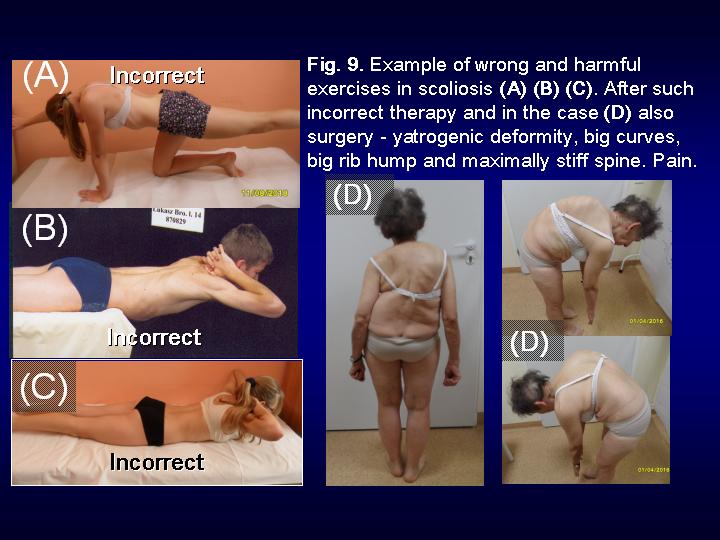 Figure 9: Example of wrong and harmful exercises in scoliosis (A) (B) (C). After such incorrect therapy and in the
case (D) also surgery - yatrogenic deformity, big curves, big rib hump and maximally stiff spine. Pain.
Figure 9: Example of wrong and harmful exercises in scoliosis (A) (B) (C). After such incorrect therapy and in the
case (D) also surgery - yatrogenic deformity, big curves, big rib hump and maximally stiff spine. Pain.
7) So-Called Idiopathic Scoliosis. Stretching exercises are proper for scoliosis. Important standing only on
the left leg & sport - karate, taekwondo, aikido, kung fu, yoga from first years of child’s life (Fig. 10).
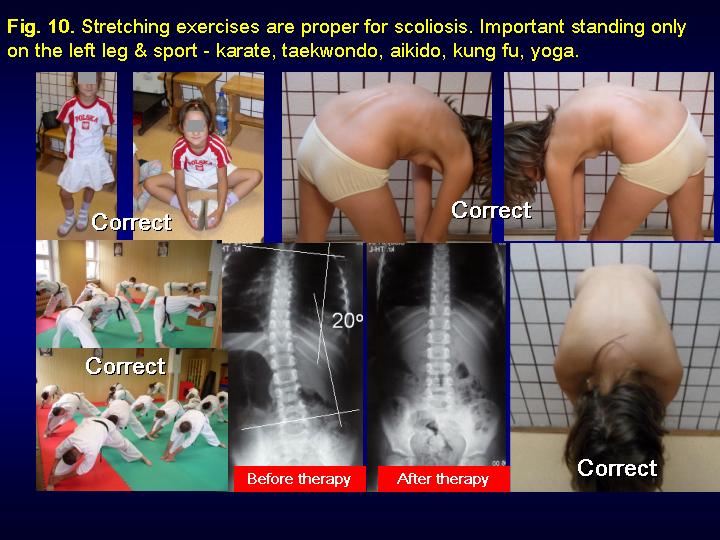 Figure 10: Stretching exercises are proper for scoliosis. Important standing only on the left leg & sport - karate,
taekwondo, aikido, kung fu, yoga.
Figure 10: Stretching exercises are proper for scoliosis. Important standing only on the left leg & sport - karate,
taekwondo, aikido, kung fu, yoga.
8) In Podologia (Fig. 11) - (A) (B) (C) (D) (E) (F) important proper shoes. (A) and (B) shoes improper
- (A) reduce dorsal flexion in ankle joint and (B) reduce the plantar flexion of toes in metatarsal phalange
joints. In effect - pain, difficulties in walking. In photos (C) and (D) proper exercise for toes. In picture (E)
improper getting out of the car - one leg - in result rotation distortion of ankle joint and knee. Pain, swelling
and difficulties in walking. In picture (F) proper getting out of the car- two legs. Publication about this
subject in USA, India, Czech Republic (2016 - 2021). See www.ortopedia.karski.lublin.pl point 17.
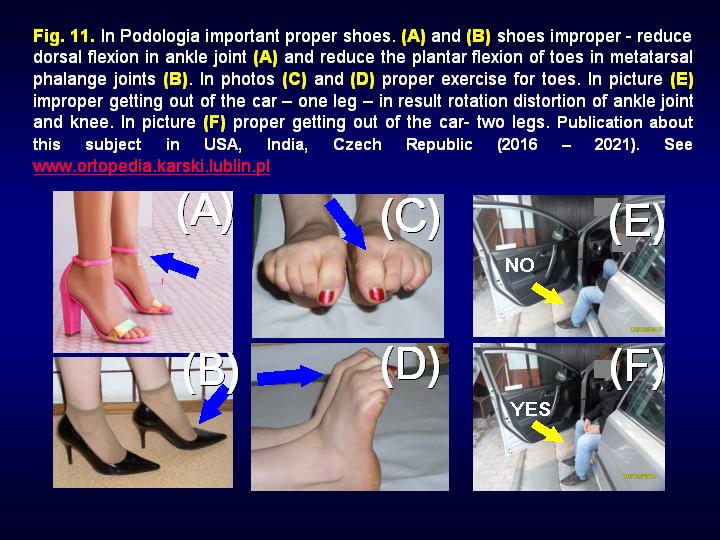 Figure 11: In Podologia important proper shoes. (A) and (B) shoes improper - reduce dorsal flexion in ankle joint
(A) and reduce the plantar flexion of toes in metatarsal phalange joints (B). In photos (C) and (D) proper exercise
for toes. In picture (E) improper getting out of the car - one leg - in result rotation distortion of ankle joint and
knee. In picture (F) proper getting out of the car- two legs. Publication about this subject in USA, India, Czech
Republic (2016 - 2021). See www.ortopedia.karski.lublin.pl
Figure 11: In Podologia important proper shoes. (A) and (B) shoes improper - reduce dorsal flexion in ankle joint
(A) and reduce the plantar flexion of toes in metatarsal phalange joints (B). In photos (C) and (D) proper exercise
for toes. In picture (E) improper getting out of the car - one leg - in result rotation distortion of ankle joint and
knee. In picture (F) proper getting out of the car- two legs. Publication about this subject in USA, India, Czech
Republic (2016 - 2021). See www.ortopedia.karski.lublin.pl
9) Map of Poland (Fig. 12). Colored fields - geothermal waters. White fields - geothermal area not recognized.
Prepared by: R. Ney, J. Sokołowski. J. Zimny. In physiotherapy especially important and profitable are
exercises in geothermal water. Geothermal Rehabilitation Centers - will be the future for Poland.
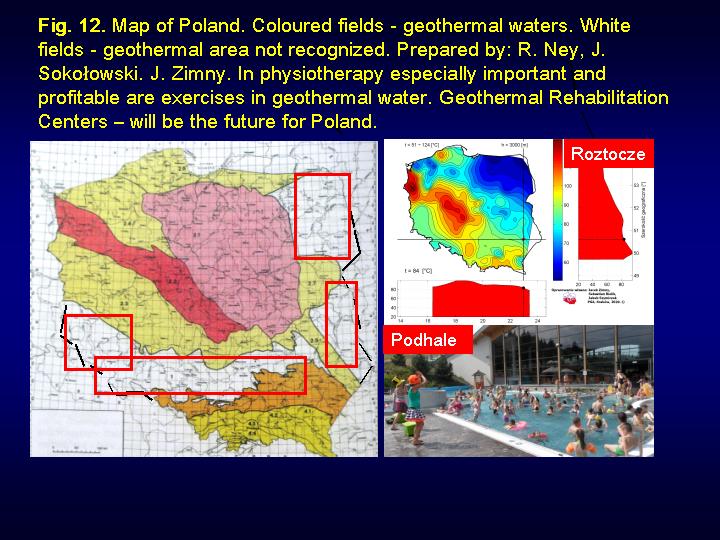 Figure 12: Map of Poland. Coloured fields - geothermal waters. White fields - geothermal area not recognized.
Prepared by: R. Ney, J. Sokołowski. J. Zimny. In physiotherapy especially important and profitable are exercises in
geothermal water. Geothermal Rehabilitation Centers - will be the future for Poland.
Figure 12: Map of Poland. Coloured fields - geothermal waters. White fields - geothermal area not recognized.
Prepared by: R. Ney, J. Sokołowski. J. Zimny. In physiotherapy especially important and profitable are exercises in
geothermal water. Geothermal Rehabilitation Centers - will be the future for Poland.
10) Discussion and Conclusions: Many of older ill people have the symptoms of hips arthrosis or back pain
or knee pain syndrome, many of youths persons have scoliosis. The prophylaxis of dysplasia of hips is very
important, because it is the first step in prevention of hip arthrosis in adults age. Proper carrying of children
is very important - it is best prophylaxis against dysplasia and next arthrosis. Unfortunately the proper
caring of a children is till now not sufficient “admitted and understandable” by many doctors and parents in
the world, mostly in Europe.
Already 27 years I present (T. Karski) the biomechanical etiology of the so-called idiopathic scoliosis. The
explanation in Poland is also “not sufficient admitted and not understandable”. But I am and co-authors
too - full of “good thought and idea” and we hope - this article will be “one important input / step in new
knowledge” of both problems - hips and spine - and will transmitted from Canada to other countries. Also
the information - about getting out from the small cars - will protect many people before the ankle joint and
knee pain syndromes.
Bibliography
- Burwell, G., Dangerfiel0d, P. H., Lowe, T. & Margulies, J. (2000). Etiology of adolescent Idiopathic Scoliosis: Current Trends and Relevance to New Treatment Approaches. Spine, 14(2).
- Dangerfield, P. H., Dorgan, J. C., Scutt, D., Gikas, G. & Taylor, J. F. (1995). Stature in Adolescent Idiopathic Scoliosis (AIS). 14 Meeting EPOS, Brussels, (P. 210).
- Green, N. E. & Griffin, P. P. (1982). Hip dysplasia associated with abduction contracture of the contralateral hip. Bone Joint Surg Am., 64(9), 1273-1281.
- Gruca, A. & Tylman, D. (1995). Patomechanika bocznych skrzywień kręgosłupa, Wydawnictwo Severus, Warszawa, Seiten 167.
- Heikkilä, E. (1984). Congenital dislocation of the hip in Finland. An epidemiologic analysis of 1035 cases. Acta Orthop. Scandinavica., 55(2),125-129.
- Hensinger, R. N. (1979). Congenital dislocation of the hip. Clinical Symposium, 31, 270.
- Howorth, B. (1977). The etiology of the congenital dislocation of the hip. Clin. Orthop., 29, 164-179.
- Karski, T. (1996). Kontrakturen und Wachstumstörungen im Hüft- und Beckenbereich in der Ätiologie der sogenannten “idiopatischen Skoliosen” - biomechanische Überlegungen. Orthopädische Praxis, 32(3) 155-160.
- Karski, T. (2002). Etiology of the so-called “idiopathic scoliosis”. Biomechanical explanation of spine deformity. Two 272 groups of development of scoliosis. New rehabilitation treatment; possibility of prophylactics. Stud Health Technol Inform., 91, 37-46.
- Karski, T., Kalakucki, J. & Karski, J. (2006). "Syndrome of contractures" (according to Mau) with the abduction contracture of the right hip as causative factor for development of the so-called idiopathic scoliosis. Stud Health Technol Inform., 123, 34-39.
- Karski Tomasz (2010). “Factores biomechanicos en la etiologia de las escoliosis dinominadas idiopaticas. Nueva 282 clasificacion. Nuevos test clinicos y nueavo tratamento conservador y profilaxis”. Cuestiones de Fisioterapia, 39(2), 144-152.
- Karski Tomasz (2010). “Biomechanical Etiology of the So-called Idiopathic Scoliosis (1995-2007). New Classification: 285 Three Groups, Four Sub-types. Connection with “Syndrome of Contractures”. Pan Arab J. Orth. Trauma., (14), 286 No 2, 287.
- Karski Tomasz (2013). Biomechanical Etiology of the So-called Idiopathic Scoliosis (1995 - 2007). Three Groups and 288 Four Types in the New Classification. Journal of Novel Physiotherapies, S2(289), 290.
- Karski Jacek & Tomasz Karski (2013). So-Called idiopathic scoliosis. diagnosis. tests examples of children incorrect 291 treated. new therapy by stretching exercises and results. Journal of Novel Physiotherapies, OMICS 3-2(9), 293.
- Karski Tomasz (2014). Biomechanical Aetiology of the So-Called Idiopathic Scoliosis. New Classification (1995 - 2007) in Connection with “Model of Hips Movements”. Global Journal of Medical Research H: Orthopedic and Musculoskeletal System, 14(3), 1-12.
- Karski Tomasz (2014). Biomechanical etiology of the so-called idiopathic scoliosis (1995 - 2007) - connection with “Syndrome of Contractures” - fundamental information for pediatricians in program of early prophylactics. Surgical Science, 2014, 5, 33-38.
- Karski Tomasz & Karski Jacek (2015). “Syndrome of contractures and deformities” according to prof. Hans Mau as primary cause of hip, neck, shank and spine deformities in babies, youth and adults. American Research Journal of Medicine and Surgery, 1(2).
- Karski Tomasz & Jacek Karski (2015). Biomechanical etiology of the so-called Idiopathic Scoliosis (1995 - 2007). Causative role of “gait” and “permanent standing ‘at ease’ on the right leg”. New classification. Principles of new therapy and causal prophylaxis. Canadian Open Medical Science & Medicine Journal, 1(1), 1-16.
- Karski Jacek, Tomasz Karski, Jarosław Pyrc & Małgorzata Kulka (2016). Deformations of the feet, knees, hips, pelvis in children and adults with minimal brain dysfunction. causes. treatment. Prophylaxis. Locomotors System, 23(2).
- Karski Tomasz (2017). Physiotherapy- correct, or incorrect, based on ‘wrong principles of treatment’. example for spine, hip, knee, shank and feet. Orthopedic Research Online Journal, 1(1), 3-6.
- Karski Tomasz, Jacek Karski, Klaudia Karska, Katarzyna Karska & Honorata Menet (2018). Pediatric prophylaxis program of motor system deformations and illnesses in children. Problems of spine, hips, knees and feet. EC Paediatrics, 7(7).
- Karski Tomasz, Jacek Karski, Katarzyna Karska, Klaudia Karska & Honorata Menet (2018). Prophylactic rules for newborns, babies, children and adults in problems of hip, knee, shank, feet and spine. Orthopedic Research Online Journal, 2(1), 110-112.
- Karski Tomasz & Jacek Karski (2016). Bóle krzyża - problem neurologiczno - ortopedyczny. Objawy. Przyczyny. Leczenie. Back pain - neurology-orthopedic problems. Clinic, causes, therapy and prophylaxis. Postępy Neurologii Praktycznej, 9-16.
- Karski Jacek & Karski Tomasz (2016). “Imperfect hips” as a problem at an older age. early and late prophylactic management before arthrosis. Jacobs Journal of Physiotherapy and Exercises, 2(1), 1-7.
- Karski Tomasz (2018). Biomechanical aetiology of the so-called adolescent idiopathic scoliosis (AIS). lublin classification (1995-2007). Causative influences connected with “Gait” and “Standing ‘at ease’ on the Right Leg”. Journal of Orthopaedics and Bone Research, 1(1), 1-10.
- Karski Tomasz (2019). Biomechanical etiology of the so-called idiopathic scoliosis, connection with “syndrome of contractures and deformities”, role of gait and standing ‘at ease’ on the right leg in the development of spine deformity, new treatment, causal prophylactics. International Journal of Orthopaedics Research, 2(1), 1-5.
- Karski Tomasz (2019). Biomechanical etiology of the so-called idiopathic scoliosis (Adolescent Idiopathic Scoliosis AIS]). New classification rules of therapy and prophylaxis. Nursing and Health Care Journal, 4(1), 143-147.
- Lowe, T. G., Edgar, M., Margulies, J. Y., Miller, N. H., Raso, V. J., Reinker, K. A., et al. (2000). Etiology of idiopathic scoliosis: current trends in research. J. Bone Joint Surg. Am., 82(8), 1157-1168.
- Malawski Stefan (1992). Epidemiologia skoliozy. Postępy Polskiej Spondyloortopedii, 5, 1-5.
- Malawski Stefan (1992). Własne zasady leczenia skolioz niskostopniowych. Postępy Polskiej Spondyloortopedii, 2, 1-2.
- Malawski, S. (1994). Własne zasady leczenia skolioz niskostopniowych w świetle współczesnych poglądów na etiologię i patogenezę powstawania skolioz. Chir. Narz. Ruchu i Ortop. Pol., 59(3), 189-197.
- Mau, H. (1979). Zur Ätiopathogenese von Skoliose, Hüftdysplasie und Schiefhals im Säuglinsalter. Zeitschrift f. 294 Orthop., 5, 601-605.
- Mau, H. (1982). Die Atiopatogenese der Skoliose, Bücherei des Orthopäden, Band 33, Enke Verlag Stuttgart, 1 - 296 110 297.
- Normelly, H. (1985). Asymmetric rib growth as an aetiological factor in idiopathic scoliosis in adolescent girls. 298 Stockholm, 1-103.
- Stokes, I. A. F. (1999). Studies in Technology and Informatics, Research into Spinal Deformities 2, 59, Amsterdam, Berlin, Oxford, Tokyo, Washington DC, 1-385.
- Sevastik, J. & Diab, K. (1997). Studies in Technology and Informatics, Research into Spinal Deformities 1, 37, Amsterdam, Berlin, 1-509.
- (2006). www.ortopedia.karski.lublin.pl.
- Zimny, J. (2010). Odnawialne źródła energii w budownictwie niskoenergetycznym, AGH, PGA, WNT, Kraków-Warszawa, 2010. Seria wydawnicza: Problemy ekoenergetyki i inżynierii środowiska. Tom 1.
- Zimny, J., Struś, M., Lech, P. & Bielik, S. (2014). Wytwarzanie energii elektFigznej z zasobów geotermicznych Polski. Akademia Górniczo-Hutnicza - Wydział Inżynierii Mechnicznej i Robotyki, Politechnika Wrocławska - Wydział Mechaniczno-Energetyczny; Szkoła Ochrony i Inżynierii Środowiska AGH; Polska Geotermalna Asocjacja, 232.
- Zimny, J., Michalak, P. & Szczotka, K. (2015). Polish heat pump market between 2000 and 2013: European background, current state and development prospects. Elsevier, Renewable and Sustainable Energy Reviews, 48(C), 791-812.
- Zimny, J., Struś, M. & Bielik, S. (2015). Wybrane problemy energetyki zasobów odnawialnych: problematyka: „Czy Polska może być samowystarczalna energetycznie do 2030 roku z własnych zasobów odnawialnych - elektrownie jądrowe czy geotermalne? - monografia naukowa. AGH, WIMIR, PWr, WME, SOIIŚ AGH, PGA, Kraków - Wrocław 2015 r., ISBN: 978-83-63318-04-8, Problemy Inżynierii Mechanicznej, Ekoenergetyki i Inżynierii Środowiska, Tom 6.
- Zimny, J., Struś, M., Kowalski, W., Szymiczek, J., Michalak, P. & Szczotka, K. (2021). Możliwości wykorzystania energii geotermalnej w Wielkopolsce - modernizacja systemu ciepłowniczego Nowego Tomyśla. Rynek Energii.












